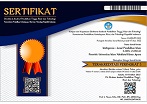Netiquette Bagi Mahasiswa Calon Guru di Era Digital
Abstract
Full Text:
PDFReferences
Berk, R. a. (2011). Top 12 be-attitudes of netiquette for academicians. The Journal of Faculty Development, 25(3), 45–48. http://newforums.metapress.com/index/6718Q773022P4347.pdf
Brunner, B. R., Yates, B. L., & Adams, J. W. (2008). Mass communication and journalism faculty and their electronic communication with college students: A nationwide examination. Internet and Higher Education, 11(2), 106–111. https://doi.org/10.1016/j.iheduc.2008.06.001
Economidou-Kogetsidis, M. (2016). Variation in evaluations of the (im)politeness of emails from L2 learners and perceptions of the personality of their senders. Journal of Pragmatics, 106, 1–19. https://doi.org/10.1016/j.pragma.2016.10.001
Fahrimal, Y. (2018). Netiquette: Etika Jejaring Sosial Generasi Milenial Dalam Media Sosial. Jurnal Penelitian Pers Dan Komunikasi Pembangunan, 22(1), 69–78. https://doi.org/10.46426/jp2kp.v22i1.82
Forgays, D. K., Hyman, I., & Schreiber, J. (2014). Texting everywhere for everything: Gender and age differences in cell phone etiquette and use. Computers in Human Behavior, 31(1), 314–321. https://doi.org/10.1016/j.chb.2013.10.053
Harrison, M. A., Bealing, C. E., & Salley, J. M. (2015). 2 TXT or not 2 TXT: College students’ reports of when text messaging is social breach. Social Science Journal, 52(2), 188–194. https://doi.org/10.1016/j.soscij.2015.02.005
Hu, C., Wong, A. F. L., Cheah, H. M., & Wong, P. (2009). Patterns of email use by teachers and implications: A Singapore experience. Computers and Education, 53(3), 623–631. https://doi.org/10.1016/j.compedu.2009.04.007
Kamau, S. M., Khamasi, K., & Kosgey, M. K. (2016). Interrogating Social Media Netiquette and Online Safety among University Students from Assorted Disciplines. 1, 61–81.
Kozík, T., & Slivová, J. (2014). Tribute to Campbell. International Journal of Engineering Pedagogy (IJEP), 4(3), 67. http://dx.doi.org/10.3991/ijep.v4i3.3570
Linek, S. B., & Ostermaier-Grabow, A. (2018). Netiquette Between Students and Their Lecturers on Facebook: Injunctive and Descriptive Social Norms. Social Media and Society, 4(3). https://doi.org/10.1177/2056305118789629
Montero-Fleta, B., & Pérez-Sabater, C. (2014). Guiding in Tertiary Education: A Case Study on Social Networking and E-Learning Platforms. Procedia - Social and Behavioral Sciences, 159, 410–414. https://doi.org/10.1016/j.sbspro.2014.12.398
Peirce, B. (1999). Email Ettiquette: Tips For Effective use. 288–289.
Pemmaraju, N., Mesa, R. A., Majhail, N. S., & Thompson, M. A. (2017). The use and impact of Twitter at medical conferences: Best practices and Twitter etiquette. Seminars in Hematology, 54(4), 184–188. https://doi.org/10.1053/j.seminhematol.2017.08.003
Republik Indonesia. (2016). Undang-Undang Nomor 19 Tahun 2016 Tentang Perubahan Atas Undang-Undang Nomor 11 Tahun 2008 Tentang Informasi Dan Transaksi Elektronik. Lembaran Negara Republik Indonesia Tahun 2016 Nomor 251, 1689–1699.
Resendes, S., Ramanan, T., Park, A., Petrisor, B., & Bhandari, M. (2012). Send IT: Study of e-mail etiquette and notions from doctors in training. Journal of Surgical Education, 69(3), 393–403. https://doi.org/10.1016/j.jsurg.2011.12.002
RI. (2008). Uu-2008-11 Informasi Dan Transaksi Elektronik. Undang-Undang, 11, 1–18. papers3://publication/uuid/8C845E4E-CD67-4476-BB4F-7123C56F0449
Soler-Costa, R., Lafarga-Ostáriz, P., Mauri-Medrano, M., & Moreno-Guerrero, A. J. (2021). Netiquette: Ethic, education, and behavior on internet—a systematic literature review. International Journal of Environmental Research and Public Health, 18(3), 1–15. https://doi.org/10.3390/ijerph18031212
Watts, L. K., Wagner, J., Velasquez, B., & Behrens, P. I. (2017). Cyberbullying in higher education: A literature review. Computers in Human Behavior, 69, 268–274. https://doi.org/10.1016/j.chb.2016.12.038
Weigelt, J. A. (2013). Professional etiquette. Journal of Surgical Education, 70(3), 291. https://doi.org/10.1016/j.jsurg.2013.03.002
Welsh, T. S., & Wright, M. S. (2010). Media literacy and visual literacy. Information Literacy in the Digital Age, 107–121. https://doi.org/10.1016/b978-1-84334-515-2.50009-3
Zeleňáková, M., Pavolová, H., & Bakalár, T. (2012). Internet Communication in the Process of Education at Universities. Procedia - Social and Behavioral Sciences, 46, 2711–2715. https://doi.org/10.1016/j.sbspro.2012
DOI: https://doi.org/10.34001/intelegensia.v10i2.3817
Article Metrics
Refbacks
- There are currently no refbacks.
Copyright (c) 2022 Intelegensia : Jurnal Pendidikan Islam

This work is licensed under a Creative Commons Attribution-ShareAlike 4.0 International License.
Currently this Journal is Indexed by

This work is licensed under a Creative Commons Attribution-ShareAlike 4.0 International License.











